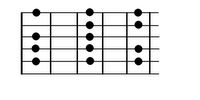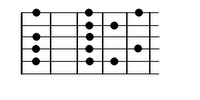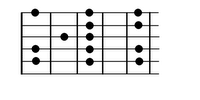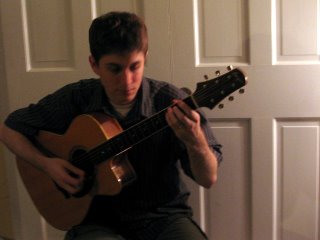Thursday (9/28) - played at Amazing Things. Fare Thee Well followed by Castle's Call/Pilgrim's flight (a Phil Keaggy night!) Both went pretty well - little mistakes, but overall about as good as I can play them, which feels great. Sound was good; talked to a guy who was at the Pierre show in April at Fall River, which helped a lot to loosen me up and relax. Fare Thee Well is a fun and sort of flashy piece to play, but it has the advantage of not being too demanding on the right hand. Pilgram's is a bit more challenging in this area, especially with the Baroque-sounding movement towards the end. The best strategy is to not rush it, but slow down if need be to gain control on the right hand; use the tempo expressively. It is easier to speed up usually than slow down, though both can be used to good effect.
The feature, Dan Gonzalez, asked if I played any Bensusan, so I stuck around for round 2 to play one for him, even though I had not planned to. I picked the Day after the Feast. It was OK, not what I would have liked. There is a lot of control required in the timing of the right hand, because there are all those arpeggios interspersed with melody/bass in Pierre's arrangment. You need to be relaxed and keep your concentration so that the right hand does not rush or lag behind, either of which will throw things completely off. Somehow, it gets easier in the 'B' section of this tune, because it is more straight-ahead chord+medoly arrangement. So, 'A' section is all right hand, 'B' is all left hand, and guess what, that means the piece actually starts out harder and gets a little easier towards the end!
Saturday (9/30) - Drove down to Acoustic Music in Guilford, CT to look at guitars. It was on the one hand a wonderful experience to play so many great instruments. But after a while it leaves me with a strange feeling - a weariness of trying to judge the flaws and attributes of so many amazingly crafted instruments. At a certain level, you know that any one of these will bring you much joy, and will shape your playing as part of the musician-instrument relationship over time. It is not good or bad, just different. How do you decide what kind of different you want? The practical reality of price is one way... can I really afford a $5000 guitar right now? No... I had an interesting conversation with the shop owner, though, where he was telling me about Pierre Bensusan's guitars and how until the Kevin Ryan that he now plays, he was playing pretty standard factory-production Lowdens. Nothing super fancy... it was his playing that mattered. It is still that way, though one might argue that the Ryan offers a kind of expressive range that is opening new doors in his music.
But it makes me tired thinking of all this... I find I am tired of thinking about things recently. Thinking about my calling as a musician, thinking about what is justified in terms of a second guitar, thinking about stage nervousness, thinking about everything. I was once introduced by a friend as "This is Tony; he thinks more than anyone I know" Ha! Flattering and sad all at once. God has given me this intensity of thought and of feeling, and that translates into an extreme sensitivity in both areas. Sometimes it just makes me totally exhausted.












